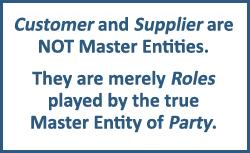Welcome to WordPress. This is your first post. Edit or delete it, then start writing!
Category: Uncategorized
Customer and Supplier are NOT Master Data Entities!
This post was prompted when I received some feedback after I ran a webinar on MDM. The feedback highlights some of the structures and thinking surrounding some MDM ‘solutions’ that, contrary to what they are sold as doing, actually contribute to MDM fragmentation.
Have a read of the feedback and my response and let me know what you think.
“John, It was a nice presentation and very different thought process from the traditional thinking of MDM implementation although I am not convinced on some of the  concepts around modelling. I have been using SAP MDM for past 8 years and SAP standards data models are restricted by entities like customer, vendor etc. and never created as a single model for party.
concepts around modelling. I have been using SAP MDM for past 8 years and SAP standards data models are restricted by entities like customer, vendor etc. and never created as a single model for party.
Based on my experience it has worked great to have models based on entities as they address needs of different business functions, different set of hierarchies being followed by for each entity and there attributes of entitiy specific to banks, sales, contacts, address linked to the relevant functions they have been used.”
My response to this was as follows.
Thank you for your feedback. It is remarkable how so many ERPs and MDM packages (even mainstream packages) have made the huge mistake of modelling and implementing Customer, Vendor, etc. as separate Master Entities!
The reality is that these are not Master Entities. They are merely Roles played by the true Master Entity ofParty, as are Roles such as Agent, Guarantor, Referee, Employee, etc, etc. This fundamental modelling error is one of the main causes of MDM fragmentation globally. 
This is not just an academic modelling error. It causes huge operational problems and can also put enterprises at serious commercial risk. This is most apparent in sectors like insurance where one Party can play many roles in a life insurance policy, such as Purchaser, Guarantor, Beneficiary, Agent, Authoriser, etc.
The approach that the packages you mention take would create each of these as a different Master Entity and expose the enterprise to significant risk. I have even seen the crazy ‘Data Quality’ solution to this of trying to identify where a Purchaser, Guarantor, Beneficiary, Agent, Authoriser have the same name and try to ‘link’ them!!! Why would you be crazy enough to create them as five separate entities and then see if they are the same thing? All, you have to do is create one occurrence of Party and assign all of the necessary Roles to that Party!
This whole problem is acerbated and perpetuated by the silo mentality that pervades so many enterprises. People in Sales only see Party in the Role of Customer and people in Purchasing only see Party in the Role of Supplier and, with this myopic and blinkered view, many actually come to believe that these are different things. Others just don’t care.
Identifying Party as the true Master Data Entity is crucial in achieving true MDM and eliminating the pains and losses that this causes enterprises worldwide.
Share the Love
If you liked this post, please share it with colleagues and friends who are committed to improving Master Data Management in their enterprise by clicking a social media button below.
To follow me on Twitter or Facebook, click on a floating icon at the bottom right corner of this window so that we can stay connected!
Work With Me
If you would to work with me and prevent these MDM Fatal Errors occurring in your enterprise then email me at john@kiwi-dreams.co.nz or Skype me on johnowensnz. I look forward to connecting with you.
Waging War on Bad Data? Give Up. You’ll lose!
War on want. War on drugs. War on terror. Have these wars eliminated want, drugs and terror? No. Some would argue, quite the opposite.
There are two main reasons for this, both allied to the human condition. The first is based on a phenomenon first observed by Carl Jung, that made him coin the term, “what you resist persists”. He arrived at this conclusion after years of observing that, when people put a lot of energy into suppressing or resisting a negative behavior or trait that, instead of disappearing, it persists and, in many instances, grows worse.
The second reason is a little darker. Imagine that tomorrow all of the agencies that have been set up around the world to fight drugs and terror could, with the wave of a magic wand, bring an end to all drug wars and acts of terror and, as a result of doing this, they could dismantle themselves and free up all of their personnel to do something else with their lives. Imagine this and then tell me, do you think that they would wave the wand and make it happen?
So It Is With the War on Bad Data
The same human traits and conditioning are at play in every enterprise. Because of this, if the means by which you have decided to eliminate bad data in your enterprise is to declare ‘war’ on it, then be aware that the situation will not significantly improve, that the financial spend will continue to grow and the number of departments and teams set up wage war on bad data will not only become in integral part of the establishment, they will grow and multiply!!!
How many such teams and departments do you have already? Data quality, data governance, data management, master data management, metadata management? More will be created. Big data and data alignment are already on their way.
What’s The Alternative?
The rationale that drives the ‘war’ on bad data is based on the same logic and thinking that has lead to the creation of all of the bad data in the in the enterprise in first place and, as Einstein points out, ‘no problem can ever be solved using the same logic that created it in the first place.’
So, an entirely new approach is needed. Enterprises need to forget about warring against bad data and concentrate instead on creating only good data. Let’s face it, if they didn’t create any bad data they will have no need to wage war on it!!!
To some people this idea will be incomprehensible; as incomprehensible as sending a man into space would have seemed only a hundred years
 ago. However, creating zero data defects is far simpler than mounting a space shot. It needs no new technology and it actually costs far less than creating defective data and then trying to find and remove it.
ago. However, creating zero data defects is far simpler than mounting a space shot. It needs no new technology and it actually costs far less than creating defective data and then trying to find and remove it.
All it needs is for enterprises to make it easier and more beneficial for people to get data right first time than it is to get it wrong. All of the resources required for this already exist. It just needs imagination and creative design to apply them properly.
Letting Go
One of the main barriers to bringing this essential mind shift about is that so many people do not want to give up the war. Some, because they find it hard to understand and accept that ‘waging war’ is a failed approach. Others enjoy the battle too much; they actually find an identity in the battle that gives them meaning – the data warrior – and they will not let go of this, no matter what price the enterprise has to pay.
Working Together
If you would like to work with me and discover ways in which your enterprise can give up its war on bad data and instead achieve the high quality data that will enable it to thrive at far less stress and cost, then contact me now.
- Email at john@jo-international.com
- Skype: johnowensnz
- Phone: +64 21 774 785 (New Zealane time).